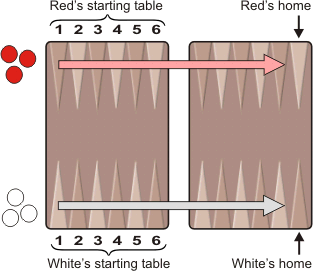![[Backgammon Galore!]](/gif/GaloreButton.gif)
|
|
Backgammon Variants Setup: Each player has just three checkers, which start off the board. Players play only on their own side of the board, moving their checkers from left-to-right across the board.
Object: The object of the game is to move all of your checkers across the board and pile them up on your home point. The first player with all three checkers on their own home point wins the game. To start: Each player rolls one die and the higher number goes first. That player then rolls the dice again to begin their first turn. Entering: You enter a checker into your starting table by rolling a number corresponding to an open point within that table. You may not enter a checker onto a point that is already occupied. Movement: The roll of the dice indicates how many points, or pips, the player is to move his checkers. The following rules apply:
If you are unable to play all of the numbers of a roll, you must play as many as you can and any unplayable numbers are lost. Hitting: In Tourne-case, you hit an opponent's checker by moving to an open point directly across the board from it. You cannot hit a checker from your home point. The hit checker is placed on the bar and must be reentered on the opponent's next turn if possible. If the opponent is unable to enter a checker sitting on the bar, he loses his turn. Scoring: The first player to move all three of their checkers to their own home point wins the game. If the losing player has entered all of their checkers, and has no checkers sitting on the board, he loses one point; otherwise he loses two points.
ReferencesBooks
World Wide Web
|
![]()
Backgammon Galore : Variants

